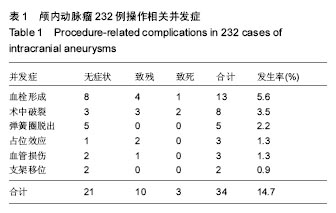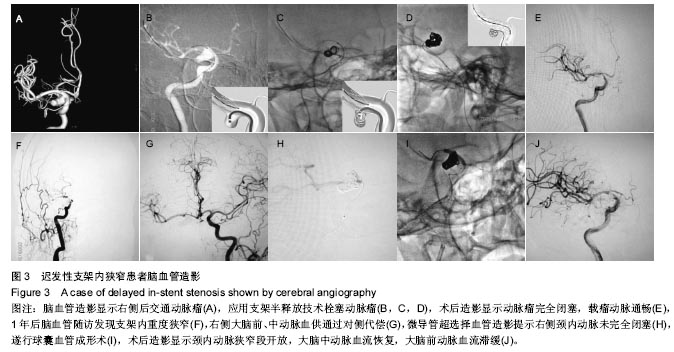| [1]吴中学.合理选择脑血管病的治疗方法[J].中华神经外科杂志, 2006, 22(8) :453.[2]Higashida RT, Smith W, Gress D, et al. Intravascular stent and endovascular coil placement for a ruptured fusiform aneurysm of the basilar artery. Case report and review of the literature. J Neurosurg. 1997;87(6):944-949.[3]Wolstenholme J, Rivero-Arias O, Gray A, et al. Treatment pathways, resource use, and costs of endovascular coiling versus surgical clipping after aSAH. Stroke. 2008;39(1): 111-119.[4]Yahia AM, Gordon V, Whapham J, et al. Complications of Neuroform stent in endovascular treatment of intracranial aneurysms. Neurocrit Care. 2008;8(1):19-30.[5]Qian Z, Feng X, Kang H, et al. Ruptured Wide-Necked Aneurysms: Is Stent-Assisted Coiling During Posthemorrhage Days 4-10 Safe and Efficient. World Neurosurg. 2017;101: 137-143.[6]Lv X, Li Y, Jiang C, et al. Potential advantages and limitations of the Leo stent in endovascular treatment of complex cerebral aneurysms. Eur J Radiol. 2011;79(2):317-322.[7]张亮,吕明,李佑祥,等. 支架辅助栓塞颅内宽颈动脉瘤手术相关出血性与缺血性并发症的危险因素分析[J].中国微侵袭神经外科杂志, 2016,21(2):49-52.[8]Liang G, Gao X, Li Z, et al. Neuroform stent-assisted coiling of intracranial aneurysms: a 5 year single-center experience and follow-up. Neurol Res. 2010;32(7):721-727.[9]Yahia AM, Latorre J, Gordon V, et al. Thromboembolic events associated with Neuroform stent in endovascular treatment of intracranial aneurysms. J Neuroimaging. 2010;20(2):113-117.[10]Murayama Y, Nien YL, Duckwiler G, et al. Guglielmi detachable coil embolization of cerebral aneurysms: 11 years' experience. J Neurosurg. 2003;98(5):959-966.[11]Mericle RA, Lanzino G, Wakhloo AK, et al. Stenting and secondary coiling of intracranial internal carotid artery aneurysm: technical case report. Neurosurgery. 1998; 43(5):1229-1234.[12]Park HK, Horowitz M, Jungreis C, et al. Periprocedural morbidity and mortality associated with endovascular treatment of intracranial aneurysms.AJNR Am J Neuroradiol. 2005;26(3):506-514.[13]Linzey JR, Griauzde J, Guan Z, et al. Stent-assisted coiling of cerebrovascular aneurysms: experience at a large tertiary care center with a focus on predictors of recurrence. J Neurointerv Surg. 2016 Oct 3. [Epub ahead of print][14]Sekhon LH, Morgan MK, Sorby W, et al. Combined endovascular stent implantation and endosaccular coil placement for the treatment of a wide-necked vertebral artery aneurysm: technical case report. Neurosurgery. 1998;43(2): 380-383.[15]Lubicz B, Collignon L, Raphaeli G, et al. Solitaire stent for endovascular treatment of intracranial aneurysms: immediate and mid-term results in 15 patients with 17 aneurysms. J Neuroradiol. 2010;37(2):83-88.[16]Fiorella D, Albuquerque FC, Woo H, et al. Neuroform In-stent Stenosis: Incidence, Natural History and Treatment Strategies. Neurosurgery. 2006;59(1):34-42.[17]Shin YS, Kim BM, Suh SH, et al. Wingspan stenting for intracranial atherosclerotic stenosis: clinical outcomes and risk factors for in-stent restenosis. Neurosurgery. 2013; 72(4):596-604.[18]Biondi A, Janardhan V, Katz JM, et al. Neuroform stent-assisted coil embolization of wide-neck intracranial aneurysms: strategies in stent deployment and midterm follow-up. Neurosurgery. 2007;61(3):460-468.[19]Dos Santos Souza MP, Agid R, Willinsky RA, et al. Microstent-assisted coiling for wide-necked intracranial aneurysms. Can J Neurol Sci. 2005;32(1):71-81.[20]Park HK, Horowitz M, Jungreis C, et al. Periprocedural morbidity and mortality associated with endovascular treatment of intracranial aneurysms. AJNR Am J Neuroradiol. 2005;26(3):506-514.[21]Murayama Y, Malisch T, Guglielmi G, et al. Incidence of cerebral vasospasm after endovascular treatment of acutely ruptured aneurysms: report on 69 cases. J Neurosurg. 1997; 87(6):830-835.[22]Gruber A, Ungersböck K, Reinprecht A, et al. Evaluation of cerebral vasospasm after early surgical and endovascular treatment of ruptured intracranial aneurysms. Neurosurgery. 1998;42(2):258-267.[23]Rabinstein AA, Pichelmann MA, Friedman JA, et al. Symptomatic vasospasm and outcomes following aneurysmal subarachnoid hemorrhage: a comparison between surgical repair and endovascular coil occlusion. J Neurosurg. 2003; 98(2):319-325.[24]Mu SQ, Yang XJ, Li YX, et al. Endovascular treatment of wide-necked intracranial aneurysms using of "remodeling technique" with the HyperForm balloon. Chin Med J (Engl). 2008;121(8):725-729.[25]梁晓东,王子亮,李天晓,等. 支架辅助栓塞颅内未破裂动脉瘤三种抗血小板方案围手术期并发症发生率比较[J]. 中华放射学杂志, 2016, 5(7): 531-536.[26]Katsaridis V, Papagiannaki C, Violaris C. Embolization of acutely ruptured and unruptured wide-necked cerebral aneurysms using the neuroform2 stent without pretreatment with antiplatelets: a single center experience. AJNR Am J Neuroradiol. 2006;27(5):1123-1128. |
.jpg)




.jpg)
.jpg)